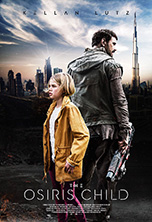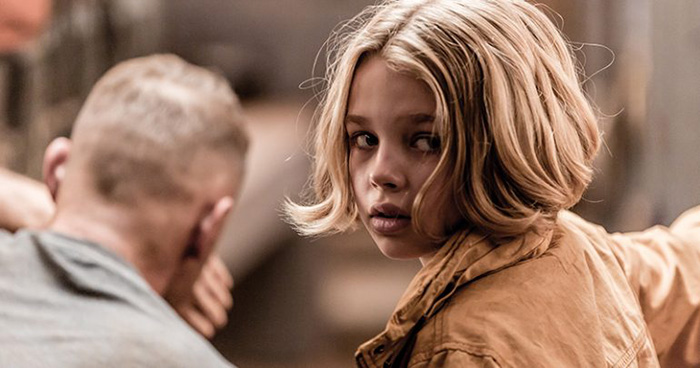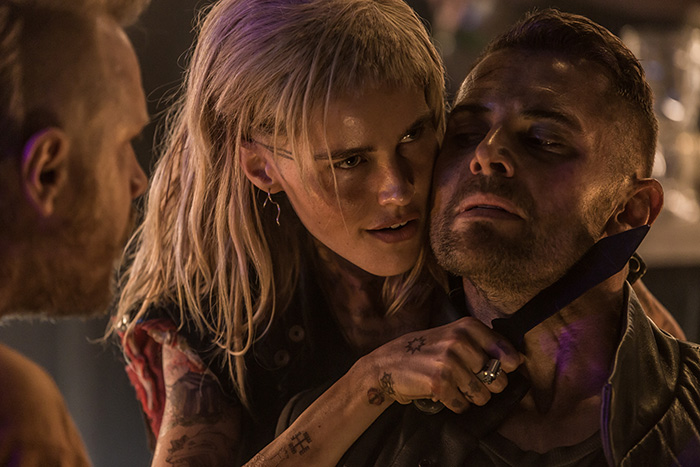Rating: NR | Runtime: 95 minutes | Release Date: May 18th, 2017 (Australia)
Studio: Madman Entertainment / RLJ Entertainment
Director(s): Shane Abbess
Writer(s): Shane Abbess / Shane Abbess & Brian Cachia (story)

“Insanity is a very common affliction around these parts”
 Here’s the harsh truth: a low-budget sci-fi from Australia propped up by its secondary lead because the actor playing him is the most recognizable and thus “bankable” star involved is never a home run. Sorry Kellan Lutz, but it’s not. The result conjures the type of shoulder shrug many bestow upon straight-to-DVD fare without taking the time to realize it’s actually hitting select theaters the same day it moves from DirecTV exclusivity to major VOD platforms. And while I would often agree with those who react this way—I admittedly do it too—Shane Abbess‘ wordily-titled The Osiris Child: Science Fiction Volume One is an exception to the rule. It looks great, proves surprisingly resonate, and even has me unironically hoping a Volume Two may yet be possible.
Here’s the harsh truth: a low-budget sci-fi from Australia propped up by its secondary lead because the actor playing him is the most recognizable and thus “bankable” star involved is never a home run. Sorry Kellan Lutz, but it’s not. The result conjures the type of shoulder shrug many bestow upon straight-to-DVD fare without taking the time to realize it’s actually hitting select theaters the same day it moves from DirecTV exclusivity to major VOD platforms. And while I would often agree with those who react this way—I admittedly do it too—Shane Abbess‘ wordily-titled The Osiris Child: Science Fiction Volume One is an exception to the rule. It looks great, proves surprisingly resonate, and even has me unironically hoping a Volume Two may yet be possible.
And why not? A sequel doesn’t need a bigger budget earned through box office success because a lot of what works here is the ingenuity necessary to produce a high concept genre film without extensive (and expensive) computer graphics. Its success comes from practical effects whether through wardrobe, elaborate sets, or creature development. It comes from a carefully laid-out script moving back and forth through time in order to ensure the audience cultivates certain preconceptions able to be reversed later on. Sometimes a cast list consisting of lesser-known talent can become a strength under these circumstances by revealing the producers know story and aesthetic is paramount. Characters can excel in two-dimensions when the world they inhabit benefits from singularly motivated pawns drawn to introduce it rather than them.
The film is told via young Indi Sommerville (Teagan Croft) who’s seen wearing an astronaut suit while exiting a cave peeking out from a desert wasteland before the credits and happily sitting alongside her father Kane (Daniel MacPherson) in a spacecraft afterwards. That initial gaze is a look at the present and thus the story’s conclusion. It allows us to connect the disembodied narrative voice to this survivor of immense hardship and her wanting-for-little-besides-quality-time-with-Dad past self. What follows is the journey taken to place her in that cave, one of tragedy, conspiracy, carnage, and sacrifice. Her visit to the colony of Osiris was to spend quality time with her father while he continued serving as a lieutenant on the terraforming flotilla above. She’s his last connection to Earth.

Unfortunately for both, this vacation’s timing couldn’t be worse. While Kane goes to work in the atmosphere, she must remain on the foreign planet’s surface as a breach occurs within the labor prison nearby. His general (Rachel Griffiths‘ Lynex) assures him that things are under control. Supposedly some escapees got their hands on a deadly virus to take Osiris hostage until demands were met, but she was confident everything would work out fine. Kane is obviously distraught at the idea his daughter is trapped by the whims of homicidal maniacs and his colonel (Andy Rodoreda‘s Michaels) sees it. Being the man who recruited Kane, Michaels decides to tell him the uncensored truth. Lynex plans on nuking the planet in twenty-three hours. To save Indi, Kane must go AWOL.
The general is acting so drastically because the real threat is a species of monster known as the “ragged”—a diseased monstrosity that looks like the love child of a Ninja Turtle and a Skeksis—and not the prisoners or a virus. These creatures have been bred as a means of colonization cleansing. Why waste the money and effort readying a planet for terraforming when you could let the “ragged” violently destroy all indigenous life without sparing one human or cent in the process? Now that they’ve been unleashed alongside mankind, however, the scales balance innocent collateral damage opposite exposing the military’s covertly immoral tactics. The former obviously wins, meaning Kane must combat both the horrors on the surface and Lynex’s intention to eradicate all witnesses from above.
Enter Sy Lombrok (Lutz). He’s the first person Kane sees upon landing and most definitely an escaped convict despite his prison nurse badge. The two make a pact: save Indi and seek refuge inside a government-grade bunker of which Kane knows the code. They’ll have to find transportation—and colorful assistance from drug-addled ingrate outlaws (Luke Ford‘s Bill and Isabel Lucas‘ Gyp)—and weapons to make it to Osiris on time with the means to survive the “ragged” force that has taken over. Before this leg of the adventure can begin, however, we must first flashback to Sy’s prison escape. It’s here that more details about the “ragged” are revealed alongside the malevolence of Warden Mourdain (Temuera Morrison). There’s much more than meets the eye to everything involved.

Abbess and co-writer Brian Cachia move through time often, always utilizing tedious interstitials marking the passing of non-linear chapters. The need for these is crucial insofar as they allow the filmmakers room to keep secrets, but necessity doesn’t negate their unwieldy presence. Not only is the title talking about “volumes” of which no more exist—this is an original saga without literary source material—but now we have chapters too? They don’t always separate past from present either with some simply excising unimportant travel time while others possess multiple time periods simultaneously. So this laborious demarcation becomes as much a crutch as integral plot device. But since memories can’t be transparently explained onscreen (Kane thinks Sy is a nurse), there isn’t really an alternative.
Luckily you do get used to them and their place as yet another cheesy detail to what’s already very much a throwback to sci-fi B-movies like The Last Starfighter or Enemy Mine. Cheesy doesn’t mean campy, though. Nothing here is intentionally or unintentionally meant to conjure anything but suspense and drama as far as saving Indi from her imminent demise. The “ragged” may look silly, but they never come across as anything other than brutally malicious. The eccentric periphery players like Bill and Gyp are inherently comical, but they understand the stakes and therefore belong inside this dystopia nonetheless. If I were to be reductive I’d say The Osiris Child was a low budget Neill Blomkamp remix with elements from Elysium and Chappie. And it works.
Alongside the action—”ragged” attacks arrive via choppy close-up cuts to get around the large costumes with assumedly poor maneuverability—is relevant commentary on political agendas and oppressive regimes sacrificing their humanity for the bottom line. But above both is the theme of family and our desire to protect loved ones no matter the cost. So despite hard-exteriors that never quite work (Lutz) and those that do (Bill and Gyp), these characters’ pasts are all complexly colored by hope. They may still end up proving clichés in the end, but not the kind you originally assume. The opportunity for redemption arises when all hell breaks loose and you may be surprised by who accepts the challenge. And while they may not all live, they’ll never again be forgotten.

